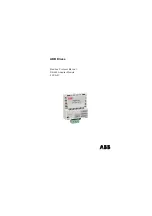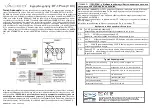
301 Fulling Mill Road, Suite G
Middletown, PA 17057
Phone (800) 321-2343 / Fax (717) 702-2546
www.onqlegrand.com
Page 1 of 8
INSTRUCTION/INSTALLATION SHEET
lyriQ™ Standard Keypad
IS-0391 REV. D
©Copyright 2009 by On-Q/Legrand All Rights Reserved.
1. Introduction
The lyriQ™ Standard Keypad, P/N AU7394-xx
(see
Figure 1
),
is an integral part of
the lyriQ™ Multi-Room Audio System. It is a component which, when combined with
other essential components (a Source Input Unit, Distribution Module and Speakers)
and your source equipment (receiver, CD player, etc.), creates a versatile whole-
house audio system that will fill your rooms with high-quality sound for years to
come. It uses Category 5 wiring to distribute audio signals, control information and
IR for remote control. The Keypad has two on-board class D amplifiers to provide a
rich level of clean sound. It also contains a full set of features, including the
integrated ability to control all other keypad volume controls in the house. It is
available in White (-WH), Light Almond (-LA), Ivory (-IV), or Black (-BK). Build an
audio system that accommodates the needs of any space by combining the lyriQ™
Standard Keypad with the lyriQ™ High Performance Keypad (AU1000-xx) in the
same system.
2. Description
The front panel of the lyriQ™ Standard Keypad
(see
Figure 1
),
contains push
buttons for VOLUME UP/DOWN (with five associated green Volume Bar Graph
LEDs), SOURCE (with four green Source Selection LEDs) and MUTE (with one red
status LED). There is also an IR target window and tri-colored status LED.
The rear of the lyriQ™ Standard Keypad (see
Figure 2
) contains an RJ45 jack (J1)
for connection to the lyriQ™ Audio Distribution Module. The TB2 speaker output
connections (left and right, plus and minus) are spring loaded and designed to
support up to 14 gauge wire. The TB1 Line Out connections (left and right, plus and
minus) are also spring loaded and designed to support up to 14 gauge wire. These
connections can be used to attach a powered subwoofer such as On-Q’s 10” (P/N
364664-01) or 12” (P/N 364671-01) subwoofer or an external amplifier.
NOTE: The lyriQ™ Standard Keypad is recommended for indoor use only.
3. Installation
Installation of the lyriQ™ Standard Keypad is best accomplished at multiple times
during new construction, at “Rough-in” before the drywall is installed, and at “Trim-
out” after the drywall is installed and painted
.
NOTE: Before connecting the volume controls: Make sure that power supplies are not connected to the
lyriQ™
Audio Modules. For instructions on pre-wiring and installing other components of the lyriQ™
Audio System, please see the Instruction Sheets included with those components.
NOTE: Always follow TIA-570-B wiring standards for installing and terminating Category 5 cable. Failure to
follow the correct wiring standard could result in damaged equipment and/or electrical interference issues.
Figure 1
Figure 2


























